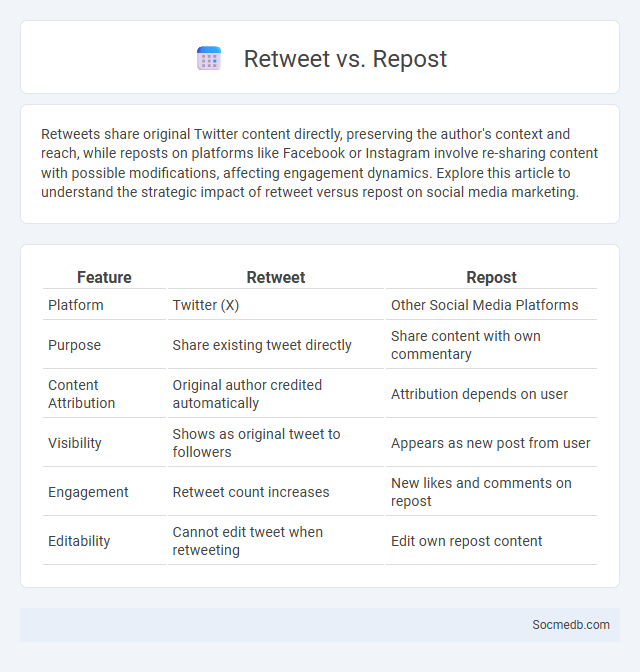
Photo illustration: Retweet vs Repost
Retweets share original Twitter content directly, preserving the author's context and reach, while reposts on platforms like Facebook or Instagram involve re-sharing content with possible modifications, affecting engagement dynamics. Explore this article to understand the strategic impact of retweet versus repost on social media marketing.
Table of Comparison
| Feature | Retweet | Repost |
|---|---|---|
| Platform | Twitter (X) | Other Social Media Platforms |
| Purpose | Share existing tweet directly | Share content with own commentary |
| Content Attribution | Original author credited automatically | Attribution depends on user |
| Visibility | Shows as original tweet to followers | Appears as new post from user |
| Engagement | Retweet count increases | New likes and comments on repost |
| Editability | Cannot edit tweet when retweeting | Edit own repost content |
Understanding the Terminology: Retweet, Repost, and Re-X
Retweet, Repost, and Re-X are key terms in social media that refer to sharing content originally created by others, but they differ by platform and functionality. Retweet is specific to Twitter, allowing users to share another's tweet directly to their followers, often with options to add comments. Repost is a broader term used across platforms like Instagram and Facebook for sharing content again, while Re-X typically refers to a generalized action of resharing or forwarding posts on various networks.
The Evolution of Sharing on Social Media
Social media platforms have transformed from simple text-based status updates to multifaceted ecosystems enabling video, live streaming, and ephemeral content sharing. Algorithms now tailor content feeds to individual preferences, enhancing user engagement and facilitating targeted advertising. User-generated content, influencers, and interactive features have redefined how people connect, express themselves, and participate in global conversations.
Retweet: Origin, Function, and Usage
The retweet function originated on Twitter in 2009 as a way to share someone else's tweet with followers, enhancing content visibility and engagement. It allows users to redistribute messages while crediting the original author, facilitating viral spread and real-time information dissemination. Retweets serve key roles in social media marketing, news propagation, and community building across platforms.
What Is a Repost? Differences from Retweet
A repost involves sharing content from one social media account to another, often used on platforms like Instagram and Facebook, whereas a retweet is specific to Twitter, allowing users to share tweets directly within the platform. Your repost typically appears as a new post on your feed, including the original content, while retweets show up as shared tweets under your profile without creating a separate post. Understanding these differences helps you effectively manage content sharing and user engagement across various social media channels.
Platform-Specific Features: Twitter, Instagram, and More
Twitter's real-time tweets and trending hashtags enhance rapid news dissemination and public engagement, while Instagram's emphasis on high-quality visuals, Stories, and Reels promotes brand storytelling and influencer marketing. Facebook integrates versatile content forms, including Groups, Events, and Marketplace, supporting community building and e-commerce activities. LinkedIn offers professional networking tools such as job postings, endorsements, and industry news feeds, making it essential for B2B marketing and career development.
User Attribution: Crediting Original Content Creators
User attribution in social media ensures original content creators receive proper credit, enhancing transparency and credibility. Platforms like Instagram and Twitter implement tagging features and attribution policies to recognize creators, fostering trust and engagement among users. Properly credited content reduces copyright infringement risks and supports content-sharing ethics across digital communities.
Virality and Reach: Impact of Retweets vs. Reposts
Retweets on Twitter amplify content reach by instantly exposing tweets to a follower's network, enhancing virality through quick, widespread redistribution. Reposts on platforms like Facebook or Instagram similarly extend audience reach but often rely on algorithmic boosts and personal network engagement for visibility. The instantaneous nature of retweets generally results in higher virality and more rapid content dissemination compared to reposts, which may generate steady, prolonged engagement.
Etiquette and Best Practices for Sharing Content
Maintaining proper etiquette on social media ensures that your content resonates respectfully with your audience and fosters positive engagement. Sharing accurate, relevant, and high-quality content while crediting original sources enhances your credibility and trustworthiness online. You should also be mindful of posting frequency and avoid oversharing, which helps maintain a balanced and engaging presence without overwhelming your followers.
Legal and Ethical Considerations
Social media platforms must navigate complex legal frameworks, including data privacy laws like GDPR and intellectual property rights to protect user content. Ethical considerations involve addressing misinformation, ensuring transparency in advertising, and combating online harassment to maintain user trust. Companies are increasingly implementing robust content moderation policies to balance free expression with community safety standards.
Which Sharing Method Should You Use?
Choosing the right social media sharing method depends on your content type and audience engagement goals. Visual content performs best using image and video sharing platforms like Instagram and TikTok, while articles and professional updates thrive on LinkedIn and Twitter. Your strategy should prioritize platforms that maximize visibility and interaction within your target demographic.
 socmedb.com
socmedb.com